Greater Sandplover (Charadrius leschenaultii)
Bolinas Lagoon, Marin County, California
2 February 2001
Joseph Morlan
Photographs © 31 January 2001 by Larry Sansone. Additional photographs © 5 February 2001 by Peter
LaTourrette are below. Click here
for RealMedia format video © 3 February 2001 by Maya Decker. All rights reserved.
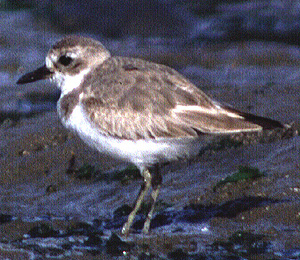 This morning I visited the
private, gated Seadrift Estates at Stinson Beach in search of a controversial sandplover, either Lesser (Mongolian
Plover Charadrius mongolus) or Greater, which had been present since 29 January 2001 when found by Steve
Howell and Sue Abbott. I arrived about 11 am to find a large group of interested birders studying the mystery sandplover
at the advertised location. However there did not appear to be a consensus on the identification.
This morning I visited the
private, gated Seadrift Estates at Stinson Beach in search of a controversial sandplover, either Lesser (Mongolian
Plover Charadrius mongolus) or Greater, which had been present since 29 January 2001 when found by Steve
Howell and Sue Abbott. I arrived about 11 am to find a large group of interested birders studying the mystery sandplover
at the advertised location. However there did not appear to be a consensus on the identification.
The following is based on notes taken while watching the bird and from memory:
It looked basically like an oversized Snowy Plover with an exceptionally large, heavy bill. I judged the bird
to be slightly larger than nearby Sanderling. Through the scope we could see that it had no white collar around
the back of the neck. The white throat contrasted strongly with crisp dark brown smudges forming a partial collar
on the sides of the breast. The demarcation at the top of the smudges was very well defined, suggesting the pattern
of a sandplover. At one point the lower feathers of the breast smudge on the left side showed an orange cast when
the bird was contorted and the feathers were seen edge-on, but during the rest of the nearly two hours of observation,
this color was not evident.
The forehead was white with faint brown freckles. The lores were white; and a very narrow white crescent could
be seen above the eye, but not below it. The ear-coverts were fairly dark brown contrasting with the pristine white
of the throat and chin which extended up the side of the neck.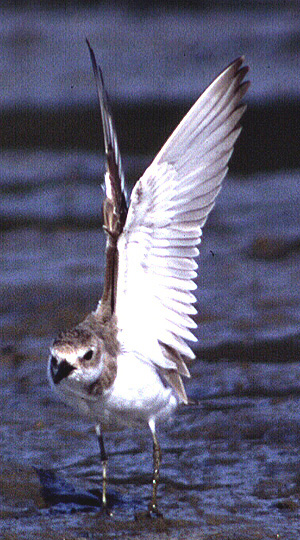
The back was a rather pale sandy-brown color, decidedly darker on the crown and upper back, paler on the hind-neck
and lower back. At least one tertial was missing revealing worn white edged tertials contrasting with fresh scapulars
on the lower back. The worn wing coverts were paler with pale tips and warmer brown than the back. The primaries
were black but the primary projection was very short. The outermost primary (p10) appeared to have a white shaft.
In flight a broad white wing-stripe was evident on the upper wing. The underwings were gleaming white, especially
near the bend of the wing where no dark carpal mark was visible.
The tail was light brown, narrowly edged with white on the sides, and fringed white at the tip. When the tail
was spread, a broad, contrasting band of blackish-brown was visible, forming an obvious subterminal band The underparts
were white, but the dark subterminal tail band was visible from below as well as above.
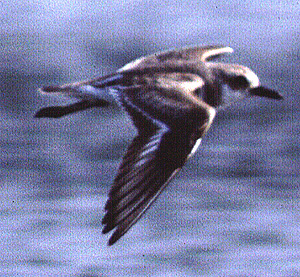 The bill and eyes were large and
dark. The bill was unique in shape. When the bird faced forward and down, the base of the bill appeared unusually
broad laterally, tapering gradually to a very fine tip. When the bird faced away slightly, the culmen appeared
to be slightly uptilted from a point closer to the head than the tip (see top photo). The overall length of the
bill was judged to be slightly more than the length of the lores and the eye. Thus, turned backward the bill would
reach slightly behind the eye.
The bill and eyes were large and
dark. The bill was unique in shape. When the bird faced forward and down, the base of the bill appeared unusually
broad laterally, tapering gradually to a very fine tip. When the bird faced away slightly, the culmen appeared
to be slightly uptilted from a point closer to the head than the tip (see top photo). The overall length of the
bill was judged to be slightly more than the length of the lores and the eye. Thus, turned backward the bill would
reach slightly behind the eye.
The legs were fairly long with a pale olive-gray or olive-yellow color depending on the light. The bird fed
at first by rapidly stamping its foot in the shallow water attempting to flush small invertebrates. As it moved
its foot, it also reflexively shook its rear end. The overall effect was of a rather neurotic foraging behavior.
However when we returned to observe the bird again at a lower tide, it fed much more sedately, pulling worms out
of the mud like a Black-bellied Plover.
Discussion
Peter Pyle pointed out that the contrast between the worn tertials and coverts and the fresh scapulars makes
this is a SY (second calendar year) bird.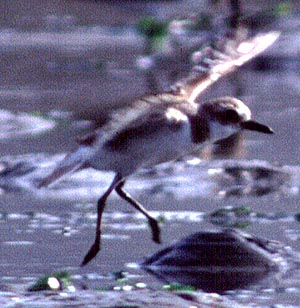
The suggestion that this bird might be a Greater Sandplover seems highly improbable based on the bird's range
in the interior of Asia and the fact that Greater Sandplover is unrecorded in the Western Hemisphere. However there
are several features this bird exhibits which appear to favor that identification. According to a recent paper
by Hirschfeld et al. (British Birds
93:162-189, 2000) the underwing of Greater Sandplover is whiter without an obvious dark carpal. Mongolian Plover
has darker underwings with a more obvious dark bar. The tail tip pattern of Greater Sandplover is more contrasting
than on Mongolian Plover which has a much fainter pattern. The legs of Greater Sandplover are longer, paler and
more olive in color. Those of Mongolian tend to be shorter and blacker. The bill of Greater Sandplover is longer
and heavier, recalling that of Wilson's Plover. That of Mongolian Plover is shorter, more stubby and more uniform
in width, recalling Semipalmated Plover. The overall coloration of Greater Sandplover is paler, recalling Snowy
Plover; that of Mongolian is darker brown, recalling Semipalmated Plover. The bill nail is more than half the bill
length in Greater Sandplover; that of Mongolian is less than 50%. In all these characters, I judged our bird to
favor Greater Sandplover.
Nevertheless, some experienced birders feel this bird is most likely a Mongolian Plover, possibly of one of
the large-billed central Asian subspecies. Its manner of feeding (foot stamping) was said to suggest Mongolian.
Also the overall size of the bird (barely larger than Sanderling) was thought to be closer to that expected of
Mongolian compared to the eastern subspecies of Greater Sandplover. However, I'm not sure that the eastern subspecies
is necessarily more expected than the smaller western race. Both of them are so far out of expected range, that
they may be equally improbable. Another character said to favor Mongolian was the apparent "cuteness"
of the bird. Greater Sandplover is said to be lanky and ungainly. Mongolian, more compact. The habitat was also
used in argument. It was suggested that Mongolian was more likely to be on mudflats, such as this bird, while Greater
Sandplover was more likely to be on dunes or beaches. Nevertheless Greater Sandplovers do use mudflats sometimes.
In sum, I think this is a very interesting bird. If it is a Mongolian Plover, it probably represents one of
the southern or interior races, rather than the expected northern coastal birds. As such is it may be geographically
no more likely to be one species of sandplover than the other. I also think that the suite of field marks listed
above would be very difficult and perhaps impossible to duplicate on a Mongolian Plover.
Thus far, attempts to capture and measure this bird have failed. Measurements should be able to solve the current
mystery. The bird has been extensively photographed.
An additional photograph, a video by Leslie Lieurance and discussion by Rich Stallcup is here.
All comments and opinions are welcome.
Added 4 February 2001
Erik Hirschfeld has kindly reviewed this record and concluded the bird is indeed a Greater Sandplover, a first
for the Americas.
Added 6 February 2001
Trevor Hardaker has now reviewed the record. His comments are here.
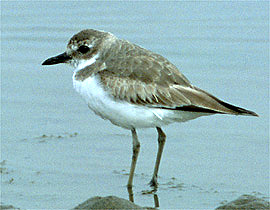 |
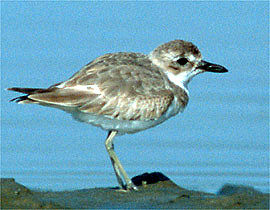 |
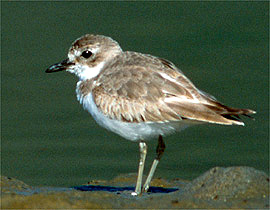 |
| These three images are © 5 February 2001 by Peter LaTourrette. All rights reserved. |
Added 7 February 2001
Peter Pyle, PRBO, 4990 Shoreline Hwy., Stinson Beach CA 94970, has requested photos be sent to him for measurement
analysis. He is looking for images showing the ratio of the bill to tarsus. More information is here.
The bird is apparently best seen seen during receding or low tides. For more practical tips click here.
Added 4 March 2001
This bird has been featured in at least three newspaper articles:
- San Francisco "Chronicle"
- Santa Rosa "Press Democrat"
- Los Angleles "Times"
Additional comments have been received by other authorities including Richard Millington (Britain), Olli Tenovuo
(Finland), Koen Verbanck (Belgium), and Geoff Carey (Hong Kong). All have endorsed the record as a Greater Sandplover
based on characters visible in these photographs.
Added 17 March 2001
The sandplover was trapped and measured on 15 March. The results confirm Greater Sandplover.
The bill and eyes were large and
dark. The bill was unique in shape. When the bird faced forward and down, the base of the bill appeared unusually
broad laterally, tapering gradually to a very fine tip. When the bird faced away slightly, the culmen appeared
to be slightly uptilted from a point closer to the head than the tip (see top photo). The overall length of the
bill was judged to be slightly more than the length of the lores and the eye. Thus, turned backward the bill would
reach slightly behind the eye.



